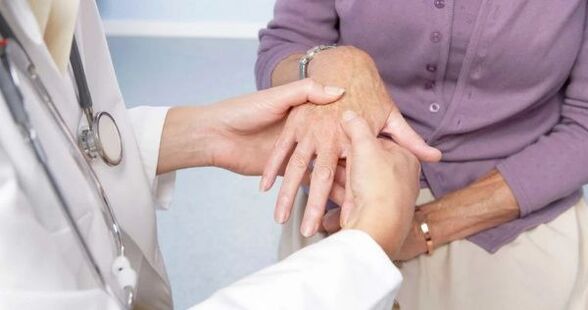
Pain in the fingersOccurs when bones, joints, soft tissues, blood vessels, nerves are affected. It can be dull, sharp, weak, intense, constant, intermittent, short-lived. Often associated with motor activity, weather conditions and other factors. Simultaneous external disorders are possible: deformities, discoloration and temperature changes, edema. Survey results, external examination, X-ray examination and other methods are used to determine the cause of pain in the fingers. Rest is recommended until diagnosis, and sometimes painkillers are taken.
Why do your fingers hurt
Traumatic injuries
An injury to a finger is characterized by moderate pain. Then the intensity of the pain gradually decreases. Edema, hyperemia, cyanosis, bleeding are possible. The function of the finger is slightly impaired. Hematomas on the palmar surface of the fingers are characterized by moderate pain, tearing of the skin with the formation of a cavity filled with dark blood. Pain with subungual hematomas is aggravated by intense, throbbing, pulsating, lowering of the brush. It is possible to partially or completely separate the nail plate.
A broken finger is accompanied by severe explosive pain during the injury. Later, the pain decreases slightly, but remains intense. The finger turns blue, swells, and its functions are severely impaired. Deformation, crepitus, pathological mobility can be detected. When a finger comes out of place, sharp pain is noted. The finger is deformed, swollen, and the spring resistance is determined when trying to move the affected joint.
In the first hours, the pain with frostbite is light, tingling. Then the pain syndrome intensifies and takes on a burning character. The finger is swollen and cyanotic. With deep frostbite, there is no sensitivity in the distal parts, the fingers are cold, pale, and pain on the border between the affected and affected tissues is disturbing.
Infectious lesions
Panaritium is characterized by rapidly increasing pain, swelling, hyperemia, cyanosis, abscess formation. Pain that deprives you of sleep at night. Particularly strong painful sensations are expressed by subungual panaritium and deep forms of the disease (bone, articular, tendon). With superficial forms of panaritium (skin, periungual, subcutaneous, subungual) the general condition suffers somewhat, symptoms of deep intoxication, fever.
Chinga develops in people who cut and process the carcasses of marine game animals, occurs with minor injuries: abrasions, wounds, cracks. It manifests itself as dull, weak pain in the wound area, after 1-2 days it is replaced by pain in the finger joint (usually proximal). The pain grows, aches, throbs, is completed by swelling, paleness, cyanosis of the finger.
Arthritis
In rheumatoid arthritis, the pain in the joints of the fingers is symmetrical. Grade 1 activity manifests itself with minor arthralgia, stiffness disappears quickly. Grade 2 pain is disturbed at rest and during movement, combined with prolonged stiffness, limited movement, redness. Grade 3 is characterized by severe persistent pain, persistent stiffness, swelling, hyperemia. Movement is severely restricted.
Gout arthritis of the fingers is more common in women. One or more joints may be affected. The pain is usually sharp, acute, and is associated with edema, hyperemia, dysfunction, and fever. Deleted symptoms are less common - minor pain and slight redness with a satisfactory general condition.
Psoriatic arthritis occurs suddenly or gradually. In the first case, the pain is moderate, growing, in the second - sharp, intense. At the peak of the disease, the typical picture includes pain aggravated at night and at rest, weakness during the day, with movements, swelling of the fingers, purple-blue color of the skin. Most distal interphalangeal joints are affected. Many deformations appear over time.
In post-traumatic arthritis, a joint is affected. Numerous lesions are characteristic of infectious-allergic forms of the disease, which develop against the background of bacterial and viral infections. With professional peripheral arthritis, the most loaded joints of the fingers are involved in the process. In all the listed forms of pathology, the pain intensifies at night, weakens during the day, and is completed by morning stiffness, local swelling and difficulty in movement. Deformities are noted with a long course.

Degenerative pathologies
Pain with osteoarthritis of the hands is initially indefinite, periodic, short-lived. There is stiffness in the morning. Later, the painful sensations intensify, stretch, sometimes burn, are marked by any movement, limit daily activities, perform delicate operations. Heberden and Bouchard nodes are formed. Lateral deformations occur.
Diseases of the joints and tendons
Patients suffering from narrow ligamentitis are concerned about pain along the palmar surface under the affected finger. At first, the pain syndrome appears only with pressure and small movements, then remains at rest. Movements are limited, accompanied by clicks. Over time, flexion contracture develops, and after one click, the arm is given pain.
In the early stages of de Quervain's disease, pain during abduction manifests itself with hyperextension of the first finger. Later, any physical activity causes painful, excruciating pain, and some patients become anxious even at rest. Typical radiation to the distal phalanx or wrist near the first finger.
Angiotrophonevrosis
Raynaud's syndrome is caused by paroxysmal numbness, vasospasm accompanied by cold fingers. The pain occurs in the second stage of the attack, has a breaking character, is accompanied by a burning sensation, fullness. The pain syndrome is short-lived, the feeling of warmth is replaced by redness of the distal parts of the hands. Pathology occurs in various diseases of various origins, including:
- rheumatoid arthritis;
- systemic lupus erythematosus;
- scleroderma;
- Sharp syndrome;
- antisynthetase syndrome;
- obliterative thromboangiitis of the upper extremities;
- endocrine, metabolic, occupational pathologies.
In the absence of other diseases that trigger this condition, they talk about Raynaud's disease with a similar pain syndrome. This form is more common in women.
Erythromelalgia occurs independently or is formed in patients with endocrine, neurological, hematological diseases. Paroxysmal attacks of bread, burning pain, edema, hyperemia of the fingers. It is possible that the pain spreads from one joint to another or occurs simultaneously in the area of both joints. The pain attacks are so strong that they prevent any movement. Pain decreases with cooling and raising of the hand, increasing with warming and lowering of the hands.
Neurological pathologies
Pain in the fingers occurs when the nerves are damaged, spreads in the innervation zone, has a firing or burning character, is accompanied by sensory disturbances, vegetative-trophic disorders. Possible neurological causes:
- Median nerve neuropathy.The pain is localized on the palmar side of fingers I-III, it is impossible to bend the fingers, squeeze the hand into a fist, to stand against the first finger.
- carpal tunnel syndrome.A type of median nerve neuropathy caused by compression of nerve fibers at the level of the wrist. Localization of pain - as in the previous case. Typical night attacks, pain when lowering arms, shaking brushes.
- Radial nerve neuropathy.With a lesion at the level of the forearm and wrist, the pain is noted along the back surface of the first finger and hand, sometimes spreading to the second and third fingers. Radiation on the wrist and numbness of the back of the hand are characteristic.
- Ulnar nerve neuropathy.The pain is mainly localized in the elbow joint, but can spread to the hands, IV-V fingers. The pain syndrome often worsens in the morning.
Tumors
Benign tumors affecting the bones of the fingers include chondromas and osteoid osteomas. Chondromas present with non-intensive localization, osteoid osteomas - with sharp pain in the affected area. Malignant neoplasia of the fingers is rare.
Other reasons
Pain in the fingers and hands is observed in patients with writing spasm, which develops with occupational neurosis and some other mental and neurological disorders. Pain occurs when typing, working on a computer or typewriter. They are broken, pulled, trembling, sudden weakness of the hand, complete with local convulsions. In addition, pain in the fingers can be detected in the following pathologies:
- Leukemia: Waldenström macroglobulinemia.
- Tumors of the adrenal glands: aldosteroma.
- Complications of diabetes: diabetic neuropathy.
- Vascular diseases: distal digital embolism as a result of occlusion of the subclavian artery.
- hereditary diseases: Fabry disease.
- Childhood diseases: neuro-arthritic diathesis.
Diagnostics
Traumatologists and orthopedists work to determine the causes of pain in the fingers. The diagnosis is made on the basis of conversation with the patient, external examination data, additional research. The diagnostic program includes:
- Inquiry. The doctor learns when and under what conditions pain syndrome and other symptoms first appear, determines the characteristics of the dynamics of the disease, the factors that lead to the improvement or deterioration of the patient's condition. Learn life history, family history.
- Physical examination. The specialist assesses the appearance of the fingers, detects deformities, inflammation, cracks, dry skin, temperature and color disorders, swelling and other manifestations of pathology. Checks sensitivity, range of motion, pulsation in peripheral arteries.
- Radiography.It is performed in two projections by holding the affected fingers or the whole hand. Confirms the presence of areas of fractures, dislocations, tumors, inflammatory and degenerative processes, destruction of solid structures in deep panaritium forms.
- Electrophysiological research.They are performed for pain of neurological origin to clarify the level of nerve damage, assess the condition of muscles and nerve conduction.
- Laboratory tests. It is produced to detect inflammation, assess the general condition of the body, and detect specific markers in collagenoses.
According to the indications, patients are referred to endocrinologists, neurologists, vascular surgeons and other specialists. Assign CT, MRI, other instrumental methods. Perform biopsy of hard and soft structures for cytological or histological examination.

Treatment
First aid
In case of traumatic injuries, a cold, high position of the joint is recommended. The hand is fixed with a splint or improvised materials (eg boards). The brush is lifted upwards or a scarf is used. Analgesic is given with severe pain syndrome, chloroethyl is applied in the absence of external damage.
Help with disease is determined by the nature of the pathology - a change in the position of the joint, warming or, conversely, cooling can help. The most common measure is rest, but in some diseases (carpal tunnel syndrome, arthritis) the pain syndrome is reduced while maintaining motor activity. Acute convulsive pain, obvious signs of inflammation, general hyperthermia are the reasons for urgent consultation with a specialist.
Conservative therapy
During fractures and fractures, local anesthesia is performed, reduction is performed, and a cast is applied. Conservative treatment of traumatic and non-traumatic pathologies of the fingers includes the following activities:
- Protective mode. It is selected taking into account the nature and severity of the disease. Possible recommendations for limiting the load, the use of orthopedic devices, the application of gypsum casting.
- Medical therapy. Non-steroidal anti-inflammatory drugs, antibiotics, drugs to improve blood circulation, neurotropic drugs are used. According to the instructions, blockades are performed with corticosteroids.
- Non-medicinal methods. Exercise therapy, massage, physiotherapy, manual therapy, kinesio taping are prescribed.
Surgical interventions
Surgery is performed when conservative methods are ineffective to reduce the duration of treatment and improve long-term results. Taking into account the characteristics of the lesion, the following is done:
- Injuries: fixation of fractures and incisions with tissue needles, amputation of fingers during necrectomy and freezing.
- Infectious diseases: opening of the panaritium, drainage, in some cases in case of serious injuries - amputation or disarticulation.
- Diseases of tendons and ligaments: rupture of the dorsal ligament and rupture of adhesions in de Quervain's disease, dissection of annular ligaments in stenotic ligamentitis.
- Neoplasms: removal of neoplasia, bone resection.
- Neurological diseases: nerve decompression.
Antibiotic therapy is prescribed after surgery. Patients undergo comprehensive rehabilitation aimed at maximizing the restoration of hand functions.



















